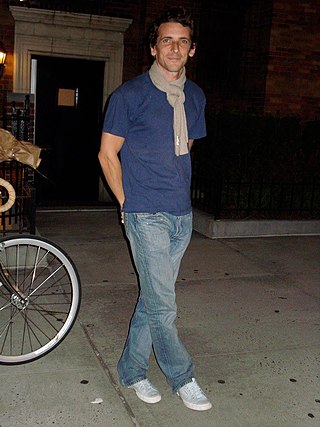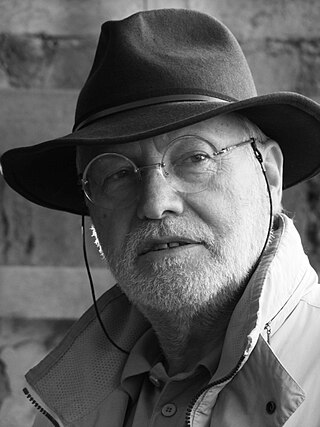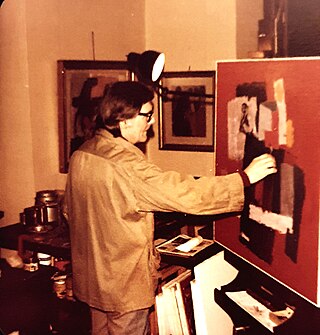This article has an unclear citation style.(March 2017) |
Julianos Kattinis | |
|---|---|
| Born | 1934 |
| Occupation | Painter |
Julianos Kattinis (born 1934) is a Greek painter who lives and works in Rome, Italy.
This article has an unclear citation style.(March 2017) |
Julianos Kattinis | |
|---|---|
| Born | 1934 |
| Occupation | Painter |
Julianos Kattinis (born 1934) is a Greek painter who lives and works in Rome, Italy.
He was born in Damascus in 1934 to Theodoros Katinis and Despina Peridakis.
His father worked as a Greek engineer and built roads in the Middle East, causing his family to move often.
He attended the French private school “Frères Lazaristes” in Damascus and spent long periods in Jerusalem, Cairo and Amman. In Damascus, Kattinis took an active part in the cultural and intellectual life of the time. He was strongly attracted by the Archeological Museum of Damascus and Palmira, full of Mesopotamian, Greek, and Roman Art, from which he absorbed much of his inspiration and imagination for his work. The town of Deir ez-Zor near the Euphrates and Maaloula were a source of stimulation for his artistic life. The sky of the desert and the white and terracotta colors of Maaloula strongly attracted him and affected his way of painting. In 1957 he was invited by the Egyptian Cultural Center of Damascus [1] for his first exhibition. In 1961 the Modern Art Gallery in Damascus invited him to exhibit his work at the Salon National de Printemps and Salon d’Automne, where he could display the variety of forms and techniques, he had long experimented.
In 1961 Kattinis decided to leave the Middle East to go to Europe, wanting to engage in the culture of 60s Europe. He settled in Rome, the town that mostly suited his idea of beauty, and here he attended the Academy of Fine Arts, where he met and made friends with his teachers, the famous painters Mario Mafai, Nino Maccari, and Giuseppe Canali, and in 1964 got his Diploma in Fine Arts. In the same year he took part in the XXXII International Venice Biennal of Art with his abstract painting [2], extremely in vogue during that time in Italy. During the long periods spent in several European towns such as Paris, Athens, Vienna, Genève, Munich, Innsbruck, he visited their museums and came into contact with the cultural life of other countries. All this strongly affected him, causing a more independent turn of his painting into a personal sort of expressionism. He went back to the Middle East in 1965, invited by the French Cultural Center in Amman (Jordan) for a solo exhibition [3] and, in Beirut (Lebanon), for a solo exhibition at the Amateur d’Art gallery. In addition, the Sursock Museum of Beirut invited him for a group exhibition [4] where he had an opportunity to meet and confront artists of different countries. A year spent in Innsbruck (Austria) (1967–68), surrounded by the beauty of the white mountains that strongly inspired him, gave way to a new phase of his art, where symbolism and expressionism merge into strongly colored images of landscapes and human beings. During this year Kattinis was invited for a solo show at the Zentrun 107 gallery in Innsbruck and at the Schuhmacher gallery in Munich (Germany). [5] The two exhibitions were extremely successful. Captured by Kattinis’ way of painting, Hans Lang Beton Firm in Innsbruck commissioned him a large, oil painting on plywood [6] On this occasion Professor Heinz von Mackovitz wrote of him “…Kattinis’ colors light up and shine with a brightness full of tension, without becoming violent, so that Kattinis’ painting arouses in the spectators a feeling of perpetual forces...” [7]
When he went back to Italy, Kattinis set up his studio in Trastevere Rome, where, in 1969, the Poliedro gallery invited him for a solo exhibition which was introduced by writings of the famous poets, writers and journalists Leonardo Sinisgalli, Ugo Mannoni, Renato Civello and Giancarlo Fusco. It was an extremely lively time in Rome, one of the European cinema’s most fertile periods, when many artists from all over the world lived and worked in Trastevere and Via Margutta. The American psychologist Giorgina Nathan Burdett got interested in his work and organized an exhibition in her studio. John Hart of the Daily American wrote: “... Kattinis has limitless imagination and prolific technical command, which lets him treat solemn themes with seemingly irreverent levity...” [8]
In 1972 Kattinis was invited at the famous Museum Palazzo Braschi of Rome, for a solo exhibition of his paintings, where the figure of man, fixed out of his temporal significance, becomes a dominant theme of his work.
The art critic Rolando Meconi curated the catalog and the issuing of Kattinis’ first album of handmade linoleum etchings in relief “Vasi Antichi“ [9]
In the following year appeared his beautiful album of 6 handmade linoleum etchings “GLI ASTRONAUTI” edited by IL Poliedro and accompanied by an introduction of Leonardo Sinisgalli [10] and writings of Sandra Giannattasio, Pietro Bianchi, Heinz Von Mackowitz.
In 1977 the Greek government organized a retrospective of his work at the Municipal Theatre (Dimotikò Thèatro) of Piraeus- Athens (Greece), and later on at Kyklos Gallery in Thessaloniki (Greece). Curator: the Greek art critic Eleni Gyzi, with articles on the Greek art magazine Kaleidoscope and Greek newspapers.[11] In Italy he was commissioned an oil painting on iron for one of the twelve doors of the old stadium by the Municipality of Bari and the Greek Embassy of Rome(1997) [12] In 2002 Kattinis was invited by The Municipality of Pisa – for an exhibition entitled ”Cantami o Diva” held in Santacroce in Fossabanda in Pisa and in Montecatini (Italy). [13] In 2003 the ( Magi’ 900) Museo d’Arte delle Generazioni Italiane del 900. G. Bargellini published the catalog “ 4 MAESTRI DELL‘INCISIONE” with the pictures of all Kattinis’ highly skilled etchings and engravings . Nicola Micieli wrote “…what mostly characterizes Kattinis’ scheme of printing, revealing his vision of the world, is his informal method used in combining and manipulating different graphic and chalcographic techniques within the same piece of work...” [14] During the years he has been commissioned exterior and interior large murals and frescoes, among which the three large frescoes inside the suites of “ Le Fabbre – Fattoria Pianetti (Manciano) Italy, inspired by the spirit of the ancient Etruscan civilization [15], together with a beautiful album of 12 multicolor etchings “ Gli Etruschi” [16] One of his works has just appeared within the exhibition entitled “Pittori del ‘900 e Carte da Gioco”, organized by Museo di Roma Palazzo Braschi [17]
Ugo Nespolo is an Italian artist, painter, sculptor, film-maker and writer. He lives and works in Turin.

Manfredi Beninati is an Italian artist born in Palermo (Sicily) in 1970. A contemporary figurative painter, his oeuvre also covers installations, drawings, sculpture, collage and film.

The Palazzo Bolognetti-Torlonia, today demolished, was a palace located in Piazza Venezia, Rome, Italy.

Antonio Papasso is an Italian painter and engraver.

Bruno Ceccobelli is an Italian painter and sculptor. He currently resides and works in Todi, Italy. Ceccobelli was one of the six artists of the Nuova Scuola Romana or Scuola di San Lorenzo, an artistic movement that grew out of the Arte Povera and Transavanguardia movements of the latter twentieth century.

Marino Alfonso, better known as Mafonso, is an Italian painter and sculptor
Giuseppe Veneziano is an Italian painter and one of the leading figures of Italian art groups "New Pop" and "Italian Newbrow".

Enrico Crispolti was an Italian art critic, curator and art historian. From 1984 to 2005, he was professor of history of contemporary art at the Università degli Studi di Siena, and director of the school of specialisation in art history. He previously taught at the Accademia di Belle Arti in Rome (1966–1973) and at the Università degli Studi di Salerno (1973–1984). He was author of the catalogues raisonnés of the works of Enrico Baj, Lucio Fontana and Renato Guttuso. He died in Rome on 8 December 2018.

The Museo di Roma is a museum in Rome, Italy, part of the network of Roman civic museums. The museum was founded in the Fascist era with the aim of documenting the local history and traditions of the "old Rome" that was rapidly disappearing, but following many donations and acquisitions of works of art is now principally an art museum. The collections initially included 120 water-colours by the nineteenth-century painter Ettore Roesler Franz of Roma sparita, "vanished Rome", later moved to the Museo di Roma in Trastevere.

The Museo di Roma in Trastevere was established in 1977 in the restored Carmelite convent of Sant'Egidio. It was initially known as the Museo del Folklore e dei Poeti Romaneschi. Following a period of closure it was reopened under its present name in 2000. In addition to a permanent collection related to the recent culture of Rome the museum also houses temporary exhibitions, including the annual World Press Photo exhibition. It is part of the Museo di Roma.
Enzo Carnebianca, is a sculptor and painter born in Rome Italy.

Nicola Rubino was an Italian sculptor and painter.
Luca Pignatelli is an Italian artist.

Sergio Sarra is an Italian artist and former basketball player.

Roberto Venturoni, was an Italian painter, engraver and sculptor.

Generoso Pompa in art Gene, pseudonym of Generoso Pompa, Italian painter of contemporary art.

Renzo Eusebi, Italian painter, sculptor of contemporary art. He is co-founder of the artistic movements of Transvisionismo (1995) and GAD.

Luigi Salvatori, Italian painter of contemporary art.

Gabriele Patriarca was an Italian informal painter and member of the art movement Scuola Romana.

Nino Camardo, italian naïve art painter.